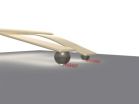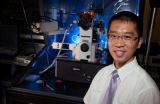(Press-News.org) 2 to 3 % of the children are born with an intellectual disability. Possibly by a genetic defect, but in 80% of these cases, we do not know – yet - which genes are responsible. VIB researchers at KU Leuven show that increased production of the HUWE1 protein is the cause in some patients.
Guy Froyen (VIB/KU Leuven): "The fact that HUWE1 regulates the dose of several other proteins in the brains, has an important impact on the quest for new therapies. It would then be possible to intervene in these different proteins. Research into the role of HUWE1 has already started in the lab."
Defects on the X-chromosome
Intellectual disability can be due to external factors such as lack of oxygen at birth or to defects in the genetic material. In genetic (hereditary) causes, the exact identification of the defect is crucial for the medical supervision of the patient or to estimate the risk when having children. It is estimated that approximately 15% of patients have a defect that lies on the X-chromosome. This is called X-linked 'intellectual disability' (XLID). Despite extensive research, in half of XLID-patients, the responsible gene responsible has not yet been identified.
HUWE1 identified as culprit
Guy Froyen and his colleagues (VIB - KU Leuven) continue their research to find new genes that may cause XLID. Several years ago, they showed that the duplication of a fragment of the X-chromosome leads to a too high concentration of HSD17B10 and HUWE1 proteins.
Guy Froyen: "We knew then that these two proteins could play an important role in the (development of) the memory center in the brains, but we did not yet know which gene was the cause for the increased dose of XLID. Through additional research, including the DNA of 6 additional families from Europe, Australia and South Africa, we now know that HUWE1 is the crucial factor, and that a concentration increase of HUWE1 leads to intellectual disability. "
Consequences for detecting and treating XLMR
The research by Guy Froyen and his colleagues offers new perspectives for the detection and treatment of XLID. This allows for tests to be designed with which the duplication of and errors in HUWE1 are searched. For the development of a new treatment for XLID, further research is required. First of all, scientists must better understand the role of HUWE1 in the body, more specifically in the brains.
### END
Too much protein HUWE1 causes intellectual disability
2012-08-31
ELSE PRESS RELEASES FROM THIS DATE:
Breathable treatment to help prevent asthma attacks
2012-08-31
Details of a treatment that could help asthmatics fight infections that trigger 80% of asthma attacks, developed by University of Southampton spin-out company Synairgen, will be presented to European respiratory experts on Sunday 2 September.
The study provides the first evidence that boosting asthmatics' immune systems can help reduce the number of asthma attacks due to the common cold and other viral infections for the 5.4 million asthmatics in the UK.
Professor Ratko Djukanovic, a respiratory specialist at the University of Southampton and Southampton General Hospital, ...
Has osteoporosis treatment failed when a fracture occurs?
2012-08-31
The International Osteoporosis Foundation (IOF) has published practical guidelines to assist clinicians in assessing treatment efficacy in patients who experience a fracture while on medication for osteoporosis.
Osteoporosis drug therapy typically reduces the risk of fracture in the range of 30-70% for vertebral fractures, 40-50% for hip fractures and 15-20% for non-vertebral fractures. Nevertheless, even an effective therapy does not completely eliminate the risk of fracture, and some patients will experience a fracture while complying with their prescribed treatment. ...
Immune system protein could explain pancreatitis
2012-08-31
It is likely that the protein is also highly significant for other inflammatory diseases.
The research results have been published in the American journal Gastroenterology.
Excessive alcohol intake and gall stones are known risk factors for acute pancreatitis. However, as yet no explanation has been found for what actually happens in the body in cases of acute pancreatitis.
Current research shows that calcium-sensitive proteins found in the body, for example calcineurin, promote inflammation, but it is not known exactly how.
Henrik Thorlacius and Maria Gomez at the ...
Danish scientists solve old blood mystery
2012-08-31
Scientists at the research centre MEMBRANES at Aarhus University, Denmark, have completed an old puzzle, which since the 60s from many sides has been regarded as impossible to complete. The challenge was to solve the structure of the protecting protein complex that forms when haemoglobin is released from red cells and becomes toxic. This toxic release of haemoglobin occurs in many diseases affecting red cell stability, e.g. malaria.
Technically, the most important finding in this report in Nature is a high-resolution three-dimensional mapping of the so-called 'haptoglobin-haemoglobin ...
Glass shape influences how quickly we drink alcohol
2012-08-31
Dr Angela Attwood and colleagues from Bristol's School of Experimental Psychology recruited 160 social drinkers aged 18-40 with no history of alcoholism to attend two experimental sessions. At one session they were asked to drink either lager or a non-alcoholic soft drink from either a straight-sided glass or a curved 'beer flute'.
The participants were almost twice as slow when drinking alcohol from the straight-sided glass compared to the curved glass. There was no difference in drinking rates from the glasses when the drink was non-alcoholic.
The researchers suggest ...
Researchers develop new, less expensive nanolithography technique
2012-08-31
Researchers from North Carolina State University have developed a new nanolithography technique that is less expensive than other approaches and can be used to create technologies with biomedical applications.
"Among other things, this type of lithography can be used to manufacture chips for use in biological sensors that can identify target molecules, such as proteins or genetic material associated with specific medical conditions," says Dr. Albena Ivanisevic, co-author of a paper describing the research. Ivanisevic is an associate professor of materials science and ...
Fear and driving opportunity motivated changes in driving behavior after 9/11
2012-08-31
A catastrophic event – such as a terrorist attack, a natural disaster, or market collapse – often strikes twice. There is the damage caused by the event itself, as lives are lost or left in ruin. But there is also the second act, catalyzed by our response to the catastrophic event. This second act has the potential to cause just as much damage as the first.
In the year following the terrorist attacks of September 11, 2001, there were approximately 1,600 more traffic fatalities in the United States than expected. This figure suggests the possibility that fear may have ...
Research yields two 'firsts' regarding protein crucial to human cardiac function
2012-08-31
TALLAHASSEE, Fla. -- Florida State University researchers led by physics doctoral student Campion Loong have achieved significant benchmarks in a study of the human cardiac protein alpha-tropomyosin, which is an essential, molecular-level component that controls the heart's contraction on every beat.
Using an imaging method called atomic force microscopy, Loong achieved two "firsts": the first direct imaging of individual alpha-tropomyosin molecules, which are very small — roughly 40 nanometers long — and the first demonstrated examples of a measure of the human cardiac ...
BUSM researchers study use of MRI in osteoarthritis
2012-08-31
(Boston) – A study conducted by researchers at Boston University School of Medicine (BUSM) shows that magnetic resonance imaging (MRI) detected a high prevalence of abnormalities associated with knee osteoarthritis in middle-aged and elderly patients that had no evidence of knee osteoarthritis in X-ray images.
Ali Guermazi, MD, PhD, professor of radiology at BUSM and chief of Musculoskeletal Imaging at Boston Medical Center (BMC), led this study in collaboration with researchers from Lund University in Sweden, Brigham and Women's Hospital in Boston and Klinikum Augsburg ...
BUSM researchers find potential key to halt progression, reverse damage from emphysema
2012-08-31
(Boston) – A study led by researchers at Boston University School of Medicine (BUSM) has shown that a compound used in some skin creams may halt the progression of emphysema and reverse some of the damage caused by the disease. When the compound Gly-His-Lys (GHK) was applied to lung cells from patients with emphysema, normal gene activity in altered cells was restored and damaged aspects of cellular function were repaired.
The study, which is published in BioMed Central's open access journal Genome Medicine, also demonstrates the potential impact of using genomic technologies ...

